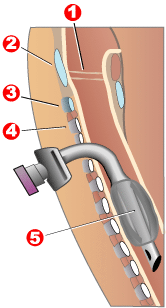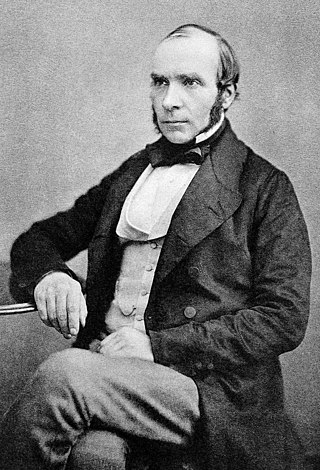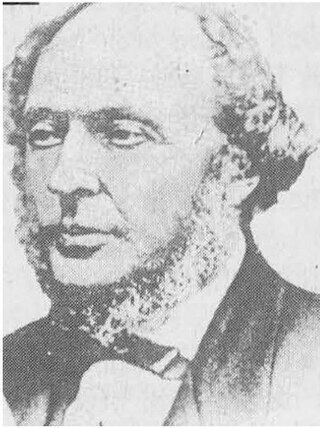Related Research Articles

Joseph Lister, 1st Baron Lister, was a British surgeon, medical scientist, experimental pathologist and a pioneer of antiseptic surgery and preventative medicine. Joseph Lister revolutionised the craft of surgery in the same manner that John Hunter revolutionised the science of surgery.

Anesthesia or anaesthesia is a state of controlled, temporary loss of sensation or awareness that is induced for medical or veterinary purposes. It may include some or all of analgesia, paralysis, amnesia, and unconsciousness. An individual under the effects of anesthetic drugs is referred to as being anesthetized.

Tracheotomy, or tracheostomy, is a surgical airway management procedure which consists of making an incision (cut) on the anterior aspect (front) of the neck and opening a direct airway through an incision in the trachea (windpipe). The resulting stoma (hole) can serve independently as an airway or as a site for a tracheal tube or tracheostomy tube to be inserted; this tube allows a person to breathe without the use of the nose or mouth.

Twilight sleep is an amnesic state characterized by insensitivity to pain without loss of consciousness, induced by an injection of morphine and scopolamine, with the purpose of pain management during childbirth. The obstetric method originated in Germany and gained large popularity in New York City in the early 20th century.

Sir James Paget, 1st Baronet FRS HFRSE was an English surgeon and pathologist who is best remembered for naming Paget's disease and who is considered, together with Rudolf Virchow, as one of the founders of scientific medical pathology. His famous works included Lectures on Tumours (1851) and Lectures on Surgical Pathology (1853). There are several medical conditions which were described by, and later named after, Paget:

Cardiac surgery, or cardiovascular surgery, is surgery on the heart or great vessels performed by cardiac surgeons. It is often used to treat complications of ischemic heart disease ; to correct congenital heart disease; or to treat valvular heart disease from various causes, including endocarditis, rheumatic heart disease, and atherosclerosis. It also includes heart transplantation.
Oral and maxillofacial surgery is a surgical specialty focusing on reconstructive surgery of the face, facial trauma surgery, the oral cavity, head and neck, mouth, and jaws, as well as facial cosmetic surgery/facial plastic surgery including cleft lip and cleft palate surgery.

John Snow was an English physician and a leader in the development of anaesthesia and medical hygiene. He is considered one of the founders of modern epidemiology, in part because of his work in tracing the source of a cholera outbreak in London's Soho, which he identified as a particular public water pump. Snow's findings inspired the adoption of anaesthesia as well as fundamental changes in the water and waste systems of London, which led to similar changes in other cities, and a significant improvement in general public health around the world.
Vasovasostomy is a surgery by which vasectomies are partially reversed. Another surgery for vasectomy reversal is vasoepididymostomy.

Sir Benjamin Ward Richardson was a British physician, anaesthetist, physiologist, sanitarian, and a prolific writer on medical history. He was the recipient of the Fothergill gold medal, awarded by the Medical Society of London in 1854 and of the Astley Cooper triennial prize for an essay in physiology.

Samuel Guthrie (1782–1848) was an American physician. He invented a form of percussion powder and also the punch lock for igniting it, which made the flintlock musket obsolete. He discovered chloroform independently in 1831.

Osmania Medical College, formerly known as Hyderabad Medical School, is a public medical college in Hyderabad, Telangana, India. It was founded in 1846 by the 5th Nizam of Hyderabad and Berar, Afzal ud Dowla, Asaf Jah V. The college was originally affiliated to Osmania University system, now it is affiliated to the Kaloji Narayana Rao University of Health Sciences, and the Osmania General Hospital. After the establishment of the Osmania University in 1919, the school was renamed Osmania Medical College, after the seventh Nizam of Hyderabad, Mir Osman Ali Khan.
Curt Theodor Schimmelbusch was a German physician and pathologist who invented the Schimmelbusch mask, for the safe delivery of anaesthetics to surgical patients. He was also a key figure in the development of mechanical methods of sterilisation and disinfection for surgical procedures, on which his Anleitung zur aseptischen Wundbehandlung was considered a seminal work.

The Sloane Hospital for Women is the obstetrics and gynecology service within NewYork-Presbyterian Hospital and the Department of Obstetrics and Gynecology of the Columbia University College of Physicians and Surgeons (P&S) in New York City. It was founded in 1886 with Columbia P&S as a training and treatment center for obstetrics. It has provided over 100 years of obstetrical care. The hospital is located within Morgan Stanley Children's Hospital.

Thomas Keith FRCSEd was a Victorian surgeon and amateur photographer from Scotland. He developed and improved the wax paper process and his photographs are recognised for their composition and use of shade. He was an early practitioner of the operation of ovariotomy where his published results were amongst the best in the world.
Psychosurgery, also called neurosurgery for mental disorder or functional neurosurgery, is surgery in which brain tissue is destroyed with the aim of alleviating the symptoms of mental disorder. It was first used in modern times by Gottlieb Burckhardt in 1891, but only in a few isolated instances, not becoming more widely used until the 1930s following the work of Portuguese neurologist António Egas Moniz. The 1940s was the decade when psychosurgery was most popular, largely due to the efforts of American neurologist Walter Freeman; its use has been declining since then. Freeman's particular form of psychosurgery, the lobotomy, was last used in the 1970s, but other forms of psychosurgery, such as the cingulotomy and capsulotomy have survived.

Francis Brodie Imlach FRCSEd (1819-1891) was a Scottish pioneer of modern dentistry, and the first person to use chloroform on a dental patient. He helped to raise the profile of dentistry from a back street trade to full professional status.

Rupa Bai Furdoonji, born to a Parsi family, was the world's first female anesthetist. She practiced medicine in Hyderabad, and played a major role in introducing the use of chloroform as an anesthetic in India.
Armstrong Todd (1826–1873) was a nineteenth-century London surgeon credited with researching new medical conditions and procedures, including anesthetics.

William Flockhart, L.R.C.S.E. was a Scottish chemist, a pharmacist who provided chloroform to Doctor James Young Simpson for his anaesthesia experiment at 52 Queen Street, Edinburgh on 4 November 1847. This was the first use of this chemical on humans when Simpson tried it on himself and a few friends, and then used it for pain relief in obstetrics, and surgery. This changed medical practice for over a century, according to the British Medical Journal.
References
- 1 2 3 DR Mohammed Najeeb (5 July 2020). "Chloroform & how modern medicine came to Hyderabad". The Asian Age. Retrieved 9 May 2021.
- ↑ "History of Anaesthesia and Hyderabad Chloroform Commission" (PDF).
- ↑ Ala, N; Pkjp, S; Gundeti, M (2010). "Dr. (Miss) Rupa Bai Furdoonji: World's first qualified lady anaesthetist". Indian J Anaesth. 54 (3): 259–61. doi: 10.4103/0019-5049.65371 . PMC 2933491 . PMID 20885878.
- ↑ Hyderabad Chloroform Commission-1891, by Sir Asman Jah, 1891 AD